I was digging through some pictures in my cleverly disguised Richard Armitage folder when I came across this one…a favorite despite the copious costume blood:
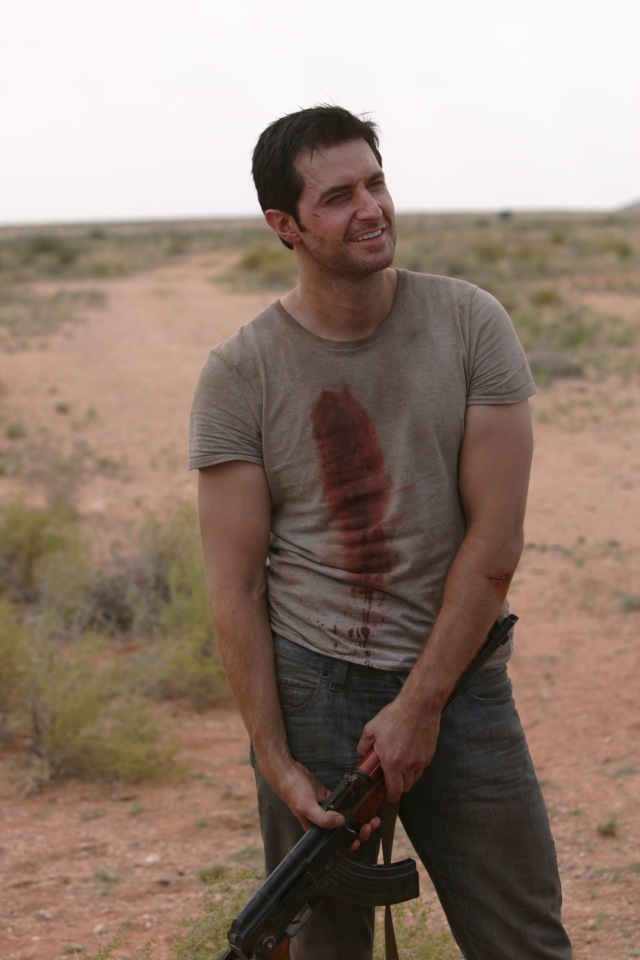
John Porter (Richard Armitage) Strikeback Behind the Scenes
Source
Look at Richard Armitage going all contrapposto!!
The art aficionados in the crowd will recognize this term as coming from the artistic tradition of the Italian Renaissance. It translates loosely to “counterpose” and refers to the body position where the weight is shifted onto one leg, turning the upper body slightly off-axis from the hips and legs. Overall, it is a position that produces a figure that looks immediately more relaxed. 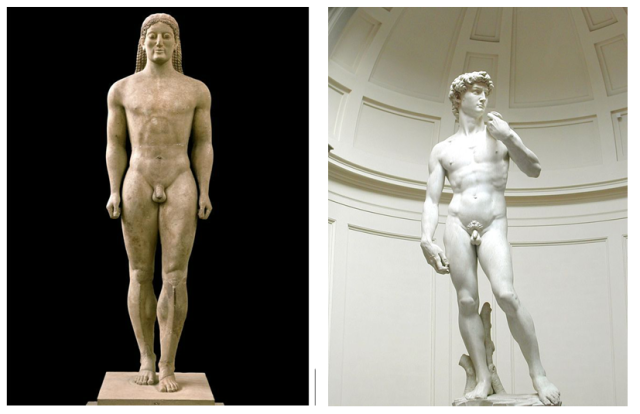
Even though the Anavysos Kouros on the left is to be understood as stepping forward, he appears stiff and static when compared to the mature Renaissance contrapposto style of Michelangelo’s David on the right. Although both of these pieces are sculpted in marble and obviously immobile, they serve to illustrate the other hallmark visual effect of contrapposto – implied movement. It seems almost inevitable that David will eventually shift his weight to the opposite leg, while the kouros appears perpetually frozen mid-stride.
What is fascinating to me is that although nearly a millenium elapsed in style and time between David and the Anavysos Kouros, the earliest known example of contrapposto is much closer to the kouros tradition than the Renaissance one. The Anavysos Kouros dates to around 530 BC. Less than fifty years later, the Greeks would embrace a very different sculptural style in a piece called the Kritias Boy
The Kritias Boy is an enormously important piece of sculpture for a number of reasons…one of them being that he is the earliest known example of the contrapposto technique and as such, marks the transition between the Archaic and Classical styles of Greek sculpture. His remarkable provenance provides secure evidence for a relatively narrow dating window for the emergence of this style in Greece. …
WARNING….short historical divergence imminent 3…..2…..1…..
The armies of the massive Persian Empire, led by Darius the First, invaded Greece in 490 BC in reprisal for what they considered Athenian interference in Persian domestic affairs. The Greeks, especially the Athenians, were scrambling. It seemed almost inevitable that Persians’ vastly superior numerical advantage would win the day. However, owing to strategic and tactical decisions made by the Athenian commander Miltiades, tiny Athens defeated the Persian force at Marathon which led to Darius’ retreat not long after.
This was a humiliating, but only temporary setback to the Persians, who immediately started ten years of planning for a massive land based invasion of the Greek mainland which would eventually be led by Darius’ son Xerxes. When Xerxes marched into Greece in 480Bc, he had a massive ax to grind against the Greeks…especially the Athenians. After the famous last stand of the Spartans at Thermopylae, Xerxes (who, contrary to his depiction in 300, was not a ten foot tall giant pierced in every possible point) marched swiftly to Athens where he sacked the abandoned city and burned it to the ground…the sacred precinct of the Acropolis included.

Kritias Boy – Located in the Acropolis Museum in Athens – my shot (note the human figures for scale)
And, we’re back. Long story short, the united forces of the Greek poleis repelled this Persian invasion as well, and by 478 BC, all that was left was to clean up the Persians’ mess. Here’s where the provenance of the Kritias Boy comes in. All of the materials on the Acropolis were considered sacred objects, so before the Athenians could rebuild from the Persian destruction, the sacred objects needed to be properly disposed of. This disposal took the form of a massive bothros, or sacred dump dug along the slopes of the Acropolis in which the sanctified materials were buried. This provides a terminus ante quem (date before which) for the sculpture…that is, we know that he must date to before the Persian sack of Athens in 480 BC. Stylistically, we also know, by comparing him to every other sculpture in the typology leading up to him, that he cannot date to much prior to 480 BC either. It is pretty clear that he was installed on the Acropolis very shortly before the Persian sack.
The utilization of contrapposto is clear in the tilt of his hips and the subtle torsion of his upper body. It is even more evident in the rear view
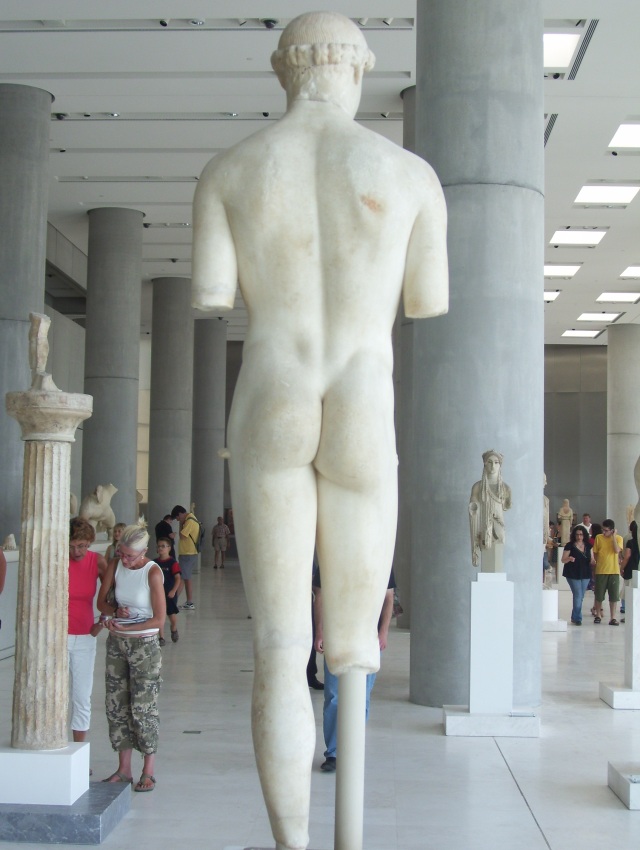
Kritias Boy Rear View
Acropolis Museum Athens
My Shot..(yep, I stood there and waited until people cleared out of my immediate frame so as not to distract…I’m patient that way!)
Here the shift of the weight onto one leg is obvious in the relative positioning of the buttocks. We can also observe the very subtle “S” curve of the upper body. In all, it is a much softer, much more naturalistic pose than what was popular in the Archaic period. This style went on to become ubiquitous in subsequent periods.
John Porter in contrapposto above is not alone in the Armitage oeuvre. I thought you might not object to a brief overview…but first, Guy of Gisborne illustrates “assuming” the contrapposto position:
Another John Porter favorite
Lucas North contrapposto from behind

Lucas is “wearing” John Porter’s thighs here…
http://www.richardarmitagenet.com
The leather contrapposto stylings of Guy of Gisborne
And more recently, Richard Armitage himself at CinemaCon
This is by no means an exhaustive list…you may have noticed that I’ve left out a spectacularly good example of Guy of Gisborne…or maybe you didn’t. Can you find it? Happy contrapposto hunting Armitageworld!
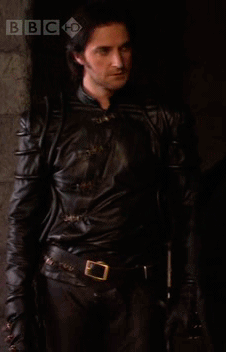

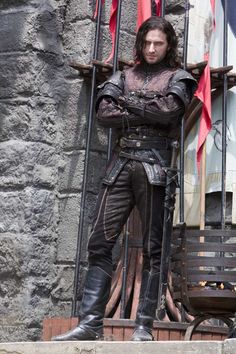

I must say – art history is interesting, anyway, but illustrated in this way… practically irresistible. Guy of Gisborne illustrating assuming the contrapposto – genius.
And now the Gisborne Challenge. Damn, which one does she mean??? I should know, but…
I’m sure you’ll know it when you see it!
I keep telling people this stuff is interesting…I guess I just need the right “props”. 🙂
I think I know the one you mean! 🙂 I have an idea that Fedoralady can find that it in no seconds flat, being one she uses frequently! 😉 He’s in his head to toe black leather and his arms are folded over his chest!! Good grief! Is it warm in here or has my fever returned?
Bingo!
http://www.richardarmitagenet.com/images/gallery/RobinHood/album/seasontwo/Episode6/slides/rh206_190.html
I have a close-up of this which cuts out most of the other people in the picture! WAY better! 😉
I love these essays, Obscura! And excellent RA character examples!
And re Teuchter’s Guy image link–his left is so right. Purrrr!
Thanks Grati! It’s the kind of data collection I never seem to mind!
😀
You go, T! 🙂
*fans self*
I feel the need for more oxygen! OOOF!!!
That seems to be a common complaint 😉
What Guylty said! 😉 History is a favorite subject of mine, but presented this way … ‘scuse me while I catch my breath. My immediate response to this challenge — ummm, thinly veiled excuse for us all to go hunting up our own favorite contRApposto views *giggle* (not that I’m complaining, prof, no ma’am) — was the image of Sir Guy thusly: http://www.richardarmitagenet.com/images/gallery/RobinHood/album/seasontwo/Episode3/slides/rh203_102.html
Of course, if I’m incorrect, I’d be more than happy to do more, extensive research. 😉 All in the name of education, of course. *cough cough*
A worthy effort! You’re close Zan, but apart from all that lovely but “distracting” skin, the camera angle is a bit oblique…the one I was thinking of is more *cough* full frontal…..
Back to the book 😀
Yes, ma’am. *goes back to researching* (What dinner party to prep for? Pshaw!)
I see Teuchter nailed it. (Go T! 😉 )
That first pic, OMG. Kalos! And kudos 😉